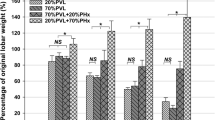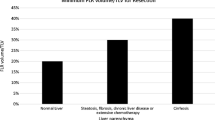Abstract
Hemihepatic portal vein embolization (PVE) concomitantly induces atrophy in embolized and compensatory hypertrophy in nonembolized hepatic lobes. The aim of the present study was to evaluate the involvement of growth stimulatory and inhibitory factors in these hepatic lobes after PVE. Liver specimens from the embolized and nonembolized lobes of ten patients who underwent hepatectomy (8–22 days) after undergoing PVE were obtained. Proliferation and apoptosis were examined immunohistochemically using Ki-67 and the Tdt-mediated dUTP-biotin nick end-labeling method. The expression of transforming growth factor-α (TGF-α) and transforming growth factor-β (TGF-β) was also examined by immunohistochemical staining. PVE induced hepatocyte apoptosis in the embolized lobe and hepatocyte proliferation in the nonembolized lobe. TGF-α expression in the hepatocytes of the nonembolized lobe was markedly increased, whereas TGF-α was also overexpressed, albeit moderately, in the embolized lobe. In contrast, TGF-β expression in the hepatocytes of the embolized lobe was significantly increased, and TGF-β expression was also increased, although to a lesser extent, in the nonembolized lobe. The degree of volume changes of the nonembolized lobe and the embolized lobe after PVE was statistically correlated with the ratios of TGF-α and TGF-β expression in these lobes (r = 0.886, P < .0001). In conclusion, these findings indicate that TGF-α and TGF-β expression (assessed by immunohistochemical staining) increase in relation to hepatocyte proliferation and apoptosis, respectively, after PVE in humans and the balance of the two factors may contribute to hepatic atrophy and hypertrophy concomitantly observed in this model.















Similar content being viewed by others
References
Mead JE, Fausto N (1989) Transforming growth factor alpha may be a physiological regulator of liver regeneration by means of an autocrine mechanism. Proc Natl Acad Sci USA 86:1558–1562
Russel WE, Dempsey PJ, Sitaric S, Peck AJ, Coffey RJ Jr (1993) Transforming growth factor-α (TGFα) concentrations increase in regenerating rat liver: evidence for a delayed accumulation of murine TGFα. Endocrinology 133:1731–1738
Evarts RP, Nakatukasa H, Marsden ER, Hu Z, Thorgeirsson SS (1992) Expression of Transforming growth factor-α in regenerating liver and during hepatic differentiation. Mol Carcinog 5:25–31
Kinoshita T, Hirao S, Matsumoto K, Nakamura T (1991) Possible endocrine control of liver regeneration after partial hepatectomy. Biochem Biophys Res Commun 177:330–335
Zarnegar R, DeFrances MC, Kost DP, Lindroos P, Michaloppoulos G (1991) Expression of hepatocyte growth factor mRNA in regenerating rat liver after partial hepatectomy. Biochem Biophys Res Commun 177:559–565
Braun L, Mead JE, Panzica M, Mikumo R, Bell GI, Fausto N (1988) Transforming growth factor beta mRNA increases during liver regeneration; a possible paracrine mechanism of growth regulation. Proc Natl Acad Sci U S A 85:1539–1543
Jakowlew SB, Mead JE, Danielpour D, Wu J, Roberts AB, Fausto N (1991) Transforming growth factor-β (TGF-β) isoforms in rat liver regeneration: messenger RNA expression and activation of latent TGF-β. Cell Regul 2:535–548
Yasuda H, Mine T, Shibata H, Eto Y, Hasegawa Y, Takeuchi T, Asano S, et al. (1993) Activin A: an autocrine inhibitor of initiation of DNA synthesis in rat hepatocytes. J Clin Invest 92:1491–1496
Gandhi CR, Murase N, Subbotin VM, Uemura T, Nalesnik M, Demetris AJ, Fung JJ, et al. (2002) Portacaval shunt causes apoptosis and liver atrophy in rats despite increases in endogenous levels of major hepatic growth factors. J Hepatol 37:340–348
Makuuchi M, Thai BL, Takayasu K, Takayama T, Kosuge T, Gunven P, Yamazaki S, et al. (1990) Preoperative portal embolization to increase safety of major hepatectomy for hilar bile duct carcinoma: a preliminary report. Surgery 107:521–527
Azoulay D, Raccuia JS, Castaing D, Bismuth H (1995) Right portal vein embolization in preparation for major hepatic resection. J Am Coll Surg 181:266–269
Farges O, Belghiti J, Kianmanesh R, Regimbeau JM, Santoro R, Vilgrain V, Denys A, et al. (2003) Portal vein embolization before right hepatectomy: prospective clinical trial. Ann Surg 237:208–217
Nagino M, Nimura Y, Kamiya J, Kondo S, Uesaka K, Kin Y, Hayakawa N, et al. (1995) Changes in hepatic lobe volume in biliary tract cancer patients after right portal vein embolization. Hepatology 21:434–439
Kubota K, Makuuchi M, Kusaka K, Kobayashi T, Miki K, Hesegawa K, Harihara Y, et al. (1997) Measurement of liver volume and hepatic functional reserve as a guide to decision-making in resectional surgery for hepatic tumors. Hepatology 26:1176–1181
Hui AM, Shi YZ, Li X, Sun L, Guido T, Takayama T, Makuuchi M (2002) Proliferative marker Ki-67 in gallbladder carcinomas: high expression level predicts early recurrence after surgical resection. Cancer Let. 176:191–198
Gravriedi Y (1992) Identification of programmed cell death in situ via specific labeling of nuclear DNA fragmentation. J Cell Biol 119:493–501
Rous P, Larimore L (1920) Relation of the portal blood to liver maintenance. J Exp Med 31:609–632
Schalm L, Bax H, Mansens B (1956) Atrophy of the liver after occlusion of the bile ducts or portal vein and compensatory hypertrophy of the unoccluded portion and its clinical importance. Gastroenterology 31:131–155
Shimizu Y, Suzuki H, Nimura Y, Onoue S, Nagino M, Tanaka M, Ozawa T (1995) Elevated mitochondrial gene expression during rat liver regeneration after portal vein ligation. Hepatology 22:1222–1229
Gerdes J, Lemke H, Baisch H, Wacker HH, Schwab U, Stein H (1984) Cell cycle analysis of a cell proliferation-associated human nuclear antigen defined by the monoclonal antibody Ki-67. J Immunol 133:1710–1715
Kamel OW, Franklin WA, Ringus JC, Meyer JS (1989) Thymidine labeling index and Ki-67 growth fraction in lesions of the breast. Am J Pathol 134:107–113
Gerlach C, Sakkab DY, Scholzen T, Dassler R, Alison MR, Gerdes J (1997) Ki-67 expression during rat liver regeneration after partial hepatectomy. Hepatology 26:573–578
Webber EM, FitzGerald MJ, Brown PI, Bartlett MH, Fausto N (1993) Transforming growth factor-alpha expression during liver regeneration after partial hepatectomy and toxic injury, and potential interactions between transforming growth factor-alpha and hepatocyte growth factor. Hepatology 18:1422–1431
Tomiya T, Ogata I, Fujiwara K (1998) Transforming growth factor α levels in liver and blood correlate better than hepatocyte growth factor with hepatocyte proliferation during liver regeneration. Am J Pathol 153:955–961
Castilla A, Prieto J, Nelson F (1991) Transforming growth factors β1 and α in chronic liver disease. Effects of interferon alfa therapy. N Engl J Med 324:933–940
Masuhara M, Yasunaga M, Tanigawa K, Tamura F, Yamashita S, Sakaida I, Okita K (1996) Expression of hepatocyte growth factor, transforming growth factor α, and transforming growth factor β1 messenger RNA in various human liver diseases and correlation with hepatocyte proliferation. Hepatology 24:323–329
Carr BI, Hayashi I, Branum EL, Moses HL (1986) Inhibition of DNA synthesis in rat hepatocytes by platelet-derived type β transforming growth factor. Cancer Res 46:2330–2334
Russel WE (1988) Transforming growth factor beta (TGF-β) inhibits hepatocyte DNA synthesis independently of EGF binding and EGF receptor autophosphorylation. J Cell Physiol 135:253–261
Oberhammer F, Pavelka M, Sharma S, Tiefenbacher R, Purchio TA, Bursch W, Schulte-Hermann R (1992) Induction of apoptosis in cultured hepatocytes and in regressing liver by transforming growth factor-beta1. Proc Natl Acad Sci U S A 89:5408–5412
Fukuda K, Kojiro M, Chiu J-F (1993) Induction of apoptosis by transforming growth factor-β1 in the rat hepatoma cell line McA-RH7777: a possible association with tissue transglutaminase expression. Hepatology 18:945–953
Harada H, Imamura H, Miyagawa S, Kawasaki S (1997) Fate of the human liver after hemihepatic portal vein embolization: cell kinetic and morphometric study. Hepatology 26:1162–1170
Fang JW, Bird GL, Nakamura T, Davis GL, Lau JY (1994) Hepatocyte proliferation as an indicator of outcome in acute alcoholic hepatitis. Lancet 343:820–823
Tu H, Jacobs SC, Borkowski A, Kyprianou N (1996) Incidence of apoptosis and cell proliferation in prostate cancer: relationship with TGF-beta1 and bcl-2 expression. Int J Cancer 69:357–363
Bissell DM, Wang SS, Jarnagin WR, Roll FJ (1995) Cell-specific expression of transforming growth factor-beta in rat liver. Evidence for autocrine regulation of hepatocyte proliferation. J Clin Invest 96:447–455
Albright CD, Zeisel SH (1997) Choline deficiency causes increased localization of transforming growth factor-β1 signaling proteins and apoptosis in the rat liver. Pathobiology 65:264–270
Jirtle RL, Carr BI, Scott CD (1991) Modulation of insulin-like growth factor-II/mannose 6-phosphate receptors and transforming growth factor-beta 1 during liver regeneration. J Biol Chem 266:22444–22450
Wada K, Nomura S, Morii E, Kitamura Y, Nishizawa Y, Miyake A, Terada N (1996) Changes in levels of mRNAs of transforming growth factor (TGF)-beta1, -beta2, -beta3, TGF-beta type II receptor and sulfated glycoprotein-2 during apoptosis of mouse uterine epithelium. J Steroid Biochem Mol Biol 59:367–375
Acknowledgments
The authors thank Dr Kimitaka Kogure, of the first Department of Surgery, Gunma University School of Medicine, Maebashi, for his technical help with the immunohistochemistry studies, and Dr Masaya Mori, of the Department of Pathology, Mitsui Memorial Hospital, for photographing our specimens. Supported in part by grants-in-aid for scientific research from the Ministry of Education, Science and Culture, and from the Ministry of Health and Welfare of Japan.
Author information
Authors and Affiliations
Corresponding author
Rights and permissions
About this article
Cite this article
Kusaka, K., Imamura, H., Tomiya, T. et al. Expression of Transforming Growth Factor-α and -β in Hepatic Lobes After Hemihepatic Portal Vein Embolization. Dig Dis Sci 51, 1404–1412 (2006). https://doi.org/10.1007/s10620-006-9105-5
Received:
Accepted:
Published:
Issue Date:
DOI: https://doi.org/10.1007/s10620-006-9105-5




